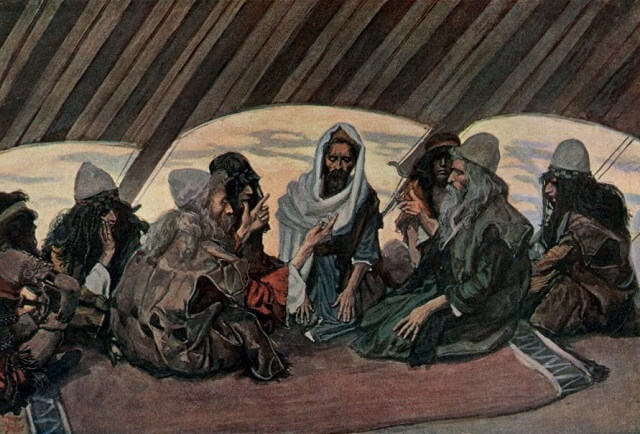(Drawing of the Temple menorah, in Rambam's own hand, in a manuscript of
his Perush Ha'Mishnayot, illustrating his comments on Menachot 3:7)
The Menorah with its seven lamps corresponded to the seven fixed stars which orbit the whole globe; the meaning of these words is that these seven fixed stars are perceived as separate light bodies in the skies exerting their respective influences on the creatures in the terrestrial world and providing guidance for our world both by day and by night. The seven lamps on the Menorah were burning around the clock by day and by night just a the seven fixed stars supply their light by day and by night without interruption. The middle lamp represented the sun which is constant in its light and the center of the seven fixed stars. (Tanchuma Beha'alotcha 5)
The Menorah with its seven lamps is an allusion to the Torah which is generally know as אור (ohr), light. This is confirmed by the verse in Mishlei 20:27 "the soul is the light of Hashem."
Torah comprises seven different kinds of (disciplines) wisdoms. This is why the Menorah had seven lamps. The six arms which extended from the center shaft represented the six different directions in our three-dimensional terrestrial globe. They were to be a reminder that all parts and all extremities of this globe are dependent on the Torah which was given to the Jewish people on the sixth of Sivan and for the sake of which the earth continues to exist. This is what Yirmeyahu 33:25 had in mind when he said, "if it were not for My covenant (with the Jewish people through the Torah) which is the basis of the day and night, etc."
THREE "CUPS" ENGRAVED LIKE ALMONDS ON THE ONE ARM."
On each arm there were 3 such "cups." This gives us a total of 18 "cups" for the six arms. The center shaft of the Menorah had 4 "cups." This means there were a total of 22 "cups." This number corresponds to the letters in the Hebrew alphabet. These 22 letters are symbolic of 22 parts of the universe:
- wind
- water
- fire
- the seven fixed stars
- the 12 signs of the zodiac
These letters in the Hebrew alphabet also are symbolized by the 22 parts of the human body:
- head
- heart
- kidneys
- seven orifices of the body
- 12 organs
(Sefer Yetzirah)
The Menorah and its arms had 3 different "decorations," there were "knobs," "cups," and "flowers."
The "knob" was like a round apple which protruded from the center shaft in every direction. The "knob" symbolized the world of the angels who are basking in the radiation of the Shechinah's brilliance in uninterrupted delight. The roundness of the "apple" symbolized the idea that something was never ending, everlasting. Our sages in Taanit 31 alluded to this delight when they said, "In the future G-d is going to make a 'circle' for the righteous and His glory will be among them." The word used by the sages is מחול (machol), something round which has no beginning and no end. This is the reason spiritual delights are always described in such terms to remind us that they are something enduring, something permanent.
The "cup" is a vessel which is a receptacle, it irrigates and provides water. This corresponds to the world of the planets and the atmosphere which at one and the same time receives beneficial input from the world of the angels and in turn distribute it beneficially to the inhabitants of the lower, terrestrial part of the universe.
The "flower" symbolizes our terrestrial part of the universe on which all the outstanding people of the earth spend their lives. They are characterized as flowers, plants, etc.
The overall idea gained from the appearance of the Menorah is that the 22 letters of the Torah (alphabet) enable man to achieve this greatness in all three parts of the universe.
(Rabbeinu Bachya, Terumah)





















